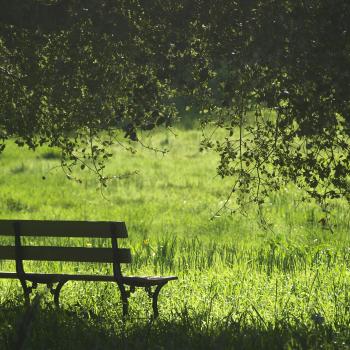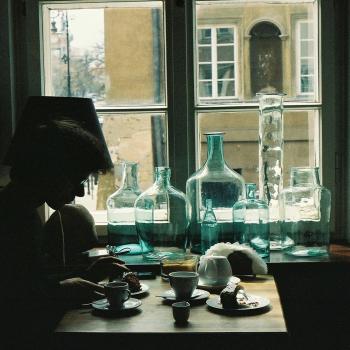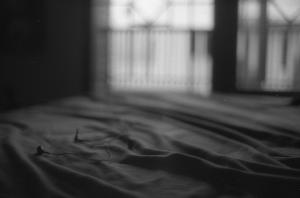 Continued from yesterday.
Continued from yesterday.
In his now infamous 2005 commencement speech at Kenyon College, David Foster Wallace tells a parable about two men, an atheist and a Christian, sitting in a bar in the Alaskan wilderness debating the existence of God. The two men interpret the world in two different ways, the believer thinking that his friend’s survival in a recent blizzard was the result of a half-hearted yet answered prayer, and the atheist believing that “all that was was two Eskimos that came along and showed me the way out.”
Wallace, raised by professors in university towns (Ithaca and then Champaign-Urbana) cautions the Kenyon students against applying too eagerly the relativistic liberal arts stance of simply allowing both men to be right because their beliefs are shaped by separate cultural forces and experiences.
Wallace says that it’s not that neither man is correct, it’s that both display “blind certainty, a close-mindedness that amounts to an imprisonment so total that the prisoner doesn’t even know he’s locked up.”
In other words, education is about freedom through self-knowledge, an interrogation of what we unthinkingly take to be true. Through self-knowledge we temper our arrogance and gain a real freedom that Wallace says allows us to “truly to care about other people and to sacrifice for them over and over in myriad petty, unsexy ways every day.”
Wallace goes on to boldly claim, “That is being educated, and understanding how to think. The alternative is unconsciousness, the default setting, the rat race, the constant gnawing sense of having had, and lost, some infinite thing.”
By framing Lane’s and Sheri’s predicament and Wallace’s Kenyon address in Christian terms, I’m not trying to claim Wallace for the Church, nor am I trying to jury-rig some causality between faith, or struggles with it, and literary excellence. But the facts are what they are.
Many of our finest, most enduring writers have written about spiritual struggle. Imagine the work of Hawthorne, Whitman, Twain, Flannery O’Connor, Updike, Cheever, etc. without theology (“reasoning or discussion concerning the Deity,” as Augustine put it) and without the arrogant American belief that we are the New Jerusalem, what Alfred Kazin calls that “high sense of himself so famous in the American character.”
Note that Wallace stood before the Kenyon class of 2005 and advised them to root out this paranoid arrogance brought on by the mere feeling of “having had, and lost, some infinite thing.”
This fear and arrogance also echoes in the chambers of Lane’s heart, a heart that he feels is slowly freezing, hardening against Sheri and against God.
The thing Sheri wants is Lane to say that he loves her. Lane knows this, but is filled with fear and dread that he does not love her. Wallace writes at the conclusion of the story:
Why is he so sure he doesn’t love her? Why is one kind of love any different? What if he has no earthly idea what love is? What would even Jesus do? . . . What if he was just afraid, if the truth was no more than this, and if what to pray for was not even love but simple courage, to meet both her eyes as she says it and trust his heart.
To my mind, this is one of the most moving passages in DFW’s work. Of course, there is some question as to whether this ending bears any resemblance to Wallace’s own thoughts on the truth. So, without assigning them to him, I do feel confident in saying that Wallace believed that fear stands in the way of embracing truth. And while it is easy to diagnose, it is hard to cure.
I’d be willing to wager that a similar fear plagued David Foster Wallace throughout his life. Was it his undoing? No, that fear alone wouldn’t suffice, but fear of the truth, of coming down on one side or the other, “choosing what to think about,” what to commit oneself to is some days a scary impossible decision, especially if your mind is as filigreed as Wallace’s.
Wallace said that religion gives you something to focus on outside of yourself, an object, a cause; what Berrigan might call the constant object of our intellects, the thing that we are constantly struggling against. Berrigan suggests we are drawn to writers like Wallace by the “vitality of the struggle . . . the power and honesty with which its terms are illuminated.”
Berrigan sees this struggle as a “vocation to the world of reality,” a vocation modeled after Jesus’ relationship to mankind, as teacher who helps the unseeing disciples reconcile the real, earthly things of this world, with the promise of transcendence.
Those who come to embrace this vocation—artists, priests, and ministers, certain scientists, and philosophers—do so not because they feel certain that they know the correct balance between the earthly and the transcendent, nor necessarily because they doubt it’s possible, but because they have a sense that it is in the space between these two poles that we shuttle; it is where we spend the vast majority of our time, and so it must be there that the answers will be found.
Though Wallace lacked any certainty as to what is next, if anything, his work unequivocally asserts that pain and suffering (psychological as well as physical) is a constant amplifier of the theological imagination. We become like Job and so many other otherwise good people who find themselves asking “Lord, why me?”
Given accounts of just how acute Wallace’s illness was and how many pages he composed in his relatively short life, he labored heroically at his vocation, and though his suicide has left us unsettled, his work points in the direction of a culprit: A culture that values the virtual rather than the actual and appearance over substance. A culture so addicted to being entertained that it is claiming our ability to be alone with ourselves.










